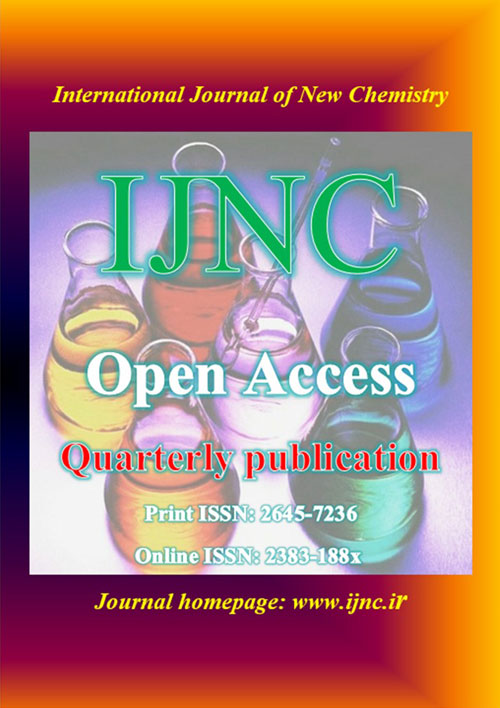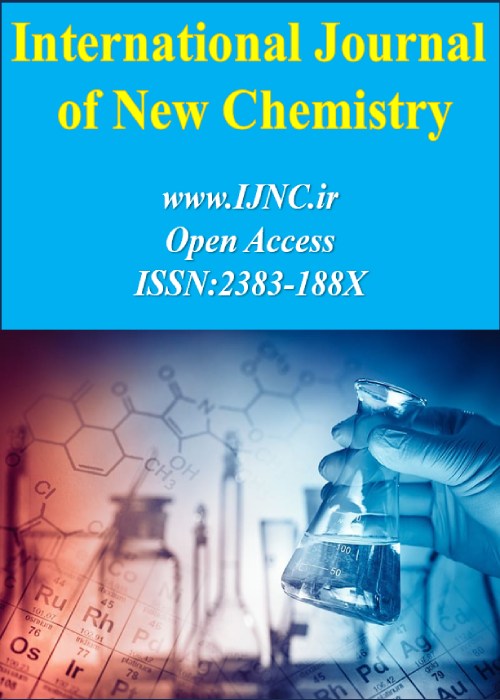فهرست مطالب

International Journal of new Chemistry
Volume:4 Issue: 1, Winter 2017
- تاریخ انتشار: 1395/10/12
- تعداد عناوین: 4
-
Pages 1-5
In this research at the first complex and its halogenated derivatives were optimized. NBO calculations and NMR for the complexes were carried out at the B3LYP/6-31G*quantum chemistry level. In the 1- (4-fluorophenyl) -2, 3-dihydro-1 H-naphto- [1, 2-e] [1, 3] oxazine-3-n, there are 4 rings, respectively, rings from the side attached to the halogen They are named C, B, A, and D. Calculations and studies show that the amount of aromatics in the halogen-ring A in all cases has the highest number. In the B loop, the predicted aromatize level is zero, and in the ring C and D, relative to the A loop, the aromaticity increase is as follows: A > D> C In the next stage of the study, with the replacement of the halogen ring A from F to I, this process was researched. In ring A, when halogens were changed, the increase in aromaticity in halogenated compounds was as follows: F> Cl> Br> I. The data in tables and graphs and shapes were compared and discussed.
Keywords: halogenated derivatives, NICS, 4-fluorophenyl -
Pages 6-11
In the combination of 5-fluorophenyl-1, 3, 7, 9-tetra methyl pyrido [2, 3, d, d, 5, 6 di pyrimidine -2, 4, 6, and 8 tetron, there are 4 rings, respectively, ring that is attached to the halogen ring A and, respectively, a ring The lower and the right to the left of the ring A are called C, B, and D. Calculations and studies show that the amount of aromatics in halogen-ring A in all cases has the highest amount. In the B and D loop, the predicted aromaticity level is low and close to zero, and there is a reduction in aromatics in the C loop than the A ring. In another stage of the study, with the replacement of the halogen ring A from F to I, the following trend was observed. In ring A, when halogens were changed, the increase in aromaticity in halogenated compounds was as follows: F> Cl> Br> I.
Keywords: NICS, aromaticity, halogenated compounds -
Pages 12-16In the 1- (4-fluorophenyl) -2,3-dihydro-1 H-naphto- [1 and 2-e] [1 and 3] oxazine-3-n, there are 4 rings, respectively, rings from the side attached to the halogen They are named C, B, A, and D. Calculations and studies show that the amount of aromatics in the halogen-ring A in all cases has the highest number. In the B loop, the predicted aromatism level is zero, and in the ring C and D, relative to the A loop, the aromaticity increase is as follows: A > D> C In the next stage of the study, with the replacement of the halogen ring A from F to I, the following process was observed.In ring A, when halogens were changed, the increase in aromaticity in halogenated compounds was as follows: F> Cl> Br> IKeywords: Aromatism, 1- (4-fluorophenyl) -2, 3-dihydro-1 H-naphto- [1, 2-e] [1, 3] oxazine-3-n
-
Pages 17-27
Chromium and molybdenum are intermediate elements of a periodic table group, both of which are both low but essential in nutrition because they play a key role in the metabolism of the chemical activity of the body. Anion analysis of these compounds in order to compare the properties of the elements of the periodic table in one The group is from the periodic table. In this paper, the quantum chemistry calculations related to the structural parameter of the two anions and the resulting complexes with glycine and alanine have been performed. The calculations have been done by HF and DFT methods and in the base series 6-31G *. NMR parameters and fixed tensors of coating and their changes have been considered. In this regard, the differences in the method in the accuracy of measurements have been considered.
Keywords: Chromium, molybdenum, HF, DFT methods


